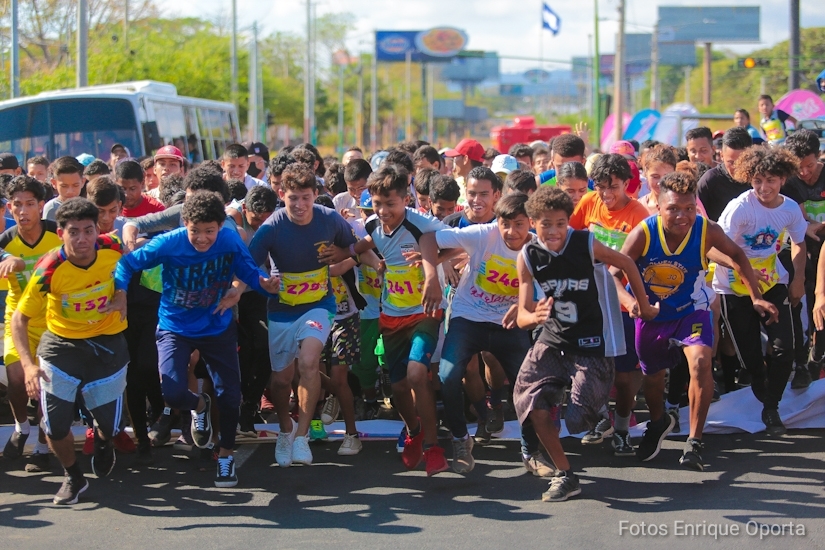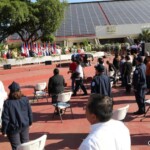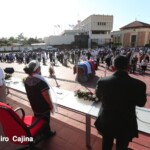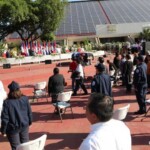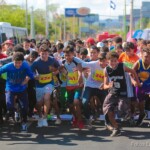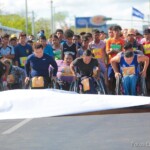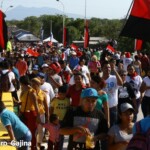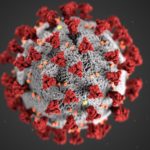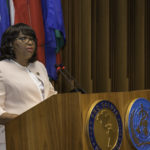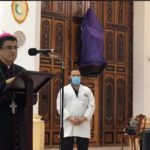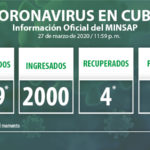It has been 25 days since the WHO declared COVID-19 a pandemic. Throughout the period, the government of Nicaragua has carried out an “intense campaign” against the virus, according to Vice President Rosario Murillo.
But her government’s response is marred by inconsistencies, recklessness, and the conspicuous absence of President Daniel Ortega.
Ortega’s last public appearance was on March 12, when he participated in a virtual meeting, called by the Central American Integration System (SICA).
In his absence, Vice President Murillo continues as the public voice of the government.
Yet Ortega is seemingly in charge, according to his wife and Vice President. Every day, Murillo assures Nicaraguans that Ortega is still, very much, at the helm. “Our comandante Daniel” as she typically calls him, is “leading all the work we carry out, minute by minute, day and night, so that we may continue being blessed.”
Interestingly enough, though, Murillo has kept herself in seclusion as well. Her daily address is delivered through a phone call, as it has been for years.
Like Ortega, Murillo has not appeared in public since March 12.
And not a single member of the Ortega-Murillo family attended the funeral of Jacinto Suárez, earlier this week.
Suárez was a “militante histórico”, a legacy member of the Sandinista organization since the 1960s. A staunch Ortega ally and personal friend, he defended the Ortega administration’s actions during the 2018 protests in Nicaragua, which he characterized as a conspiracy “sponsored and paid for by the government of the United States.”
He died of renal insufficiency, after a prolonged illness.
Instead, the Nicaraguan ruler stayed in a self-imposed quarantine in his compound at El Carmén, a decision that contradicts his government’s stance on self-isolating.
According to Jorge Romero, director of the Gaspar García Laviana Hospital in Rivas, “it makes no sense to tell people to lock themselves in, because that will only lengthen the infection period. It is alarmist and extremist”, he said during a television appearance in which he represented MINSA.
However, there are indications that the official line could change soon. On Thursday, Murillo announced an extended Easter break for all government employees, from April 4-15. She also stated that schools would be in recess from April 4 to April 20.
In spite of this covert quarantine, though, the Ortega-Murillo state apparatus is still actively organizing and promoting public events, festivals, and pageants to celebrate Easter, based on the premise that there “is no local community transmission” in the country.
The official message is supposed to be reassuring, but even the Sandinista elites themselves do not appear convinced. The funeral of Jacinto Suárez put the contradictions on full display.
The Ministry of Health (MINSA), following the WHO’s guidance about wearing masks, states that you should do so “if you are coughing or sneezing”, and that it is otherwise unnecessary for a healthy person to use a mask, unless they are caring for someone “with suspected” COVID-19 infection.
Yet photos from Jacinto Suarez’s wake show several mourners wearing masks. Among them was Francisco Rosales, a magistrate in the Nicaraguan Supreme Court of Justice and long-time member of Ortega’s inner circle.

Francisco Rosales (pictured right), wears a mask during the wake of Jacinto Suárez, in Managua.
Suárez’s funeral, the following day, was another example of the breakdown of the Ortega-Murillo government’s message. Social distancing precautions were taken, by spreading out the seating arrangements.
The majority of the Nicaraguan people are not given these protections, when they attend government-sponsored events. Public events celebrated this weekend, to kick off Easter Week, provide multiple examples of crowds, standing shoulder to shoulder. In one instance, hundreds of people gathered in Managua to run a 3.5 Kilometer foot race, dubbed “Marathon of Love,” to welcome the summer season.
Citizens fill in, where government fails.
It would be mistaken to think that the entire country is convinced that risks of contracting COVID-19 are minimal, particularly in a country where the president won’t even appear on television or attend a friend’s funeral. Citizens are sharing images of empty streets, malls, parks, and plazas.
In Jinotepe, streets are practically deserted mid-afternoon. The caption reads, “Don’t listen to the Sandinista regime and expose people to contagion.”
Jinotepe #29Marzo 3:50pm
Autoconvocados nos envían fotos de cómo está la cuarentena en la ciudad y el llamado del presidente de #ElSalvador el Sr @nayibbukele
Por favor #QuedateEnCasaNo hagamos caso al régimen Sandinista de exponer a la gente y que se contagie más#SOSNicaragua pic.twitter.com/aRtWRH0Hx2
— Mov. Nac. AutoConvocado Carazo (@ConvocadoCarazo) March 29, 2020
The streets of León are equally empty. The caption reads “If we don’t protect ourselves against this deadly virus, no one else will.”
León en paro local✊, áridas las calles. Si no nos cuidamos nosotros de este virus mortal nadie más lo hará, sigamos así👏👏👏. (1/4)#COVID19 pic.twitter.com/qTL9OLZ453
— EnlaceLeonNic (@EnlaceLeonNic) March 29, 2020
This mall, in Managua, is empty at 11:30 am. “People are protecting themselves against COVID19; they’re staying home.”
🔴LA CAPITAL SE RESGUARDA🔴
Inéditas imágenes del centro comercial Multicentro las Américas, 29/mar a las 11:30 am. 🆘️
La población se protege contra el #CODVID19 y se suma al #QuedateEnCasa. 👏
Es responsabilidad de nosotros. 👈
Fuente: @TwitterosVandalicos en TG. pic.twitter.com/2Fm0NkM7Ro
— Cheva Patriota (@29Cheva_Patria) March 29, 2020
Granada is in a similar situation. The most popular avenue in the city, La Calzada, is deserted on a Sunday evening. Granada is one of the biggest tourist attractions in the country.
Granada, Domingo 22 de marzo. 6:00 p.m. Hay más vida en un funeral que en La Calzada. Andenes vacíos. Mesas vacías. Calles vacías. Solo el pueblo salva al pueblo y los Chele a chancletudos que visitan la Ciudad Colonial, lo saben. pic.twitter.com/xDXSV0UFWP
— Café con Voz (@CafeconVozNi) March 23, 2020
Some Nicaraguan small businesses are also taking precautions. This drug store, located at the Huembes Market in Managua, placed tape to enforce social distancing. The signs ask customers to “pay by credit card, preferably, because it contaminates less”, and to “not be an accomplice to the coronavirus. If you have a cough, cover up”.
En el mercado Huembes de #Managua la gente toma sus propias medidas ante la falta de información de las autoridades de Salud.#Covid19 pic.twitter.com/sCGZwUyoE7
— Cristhian Alvarenga (@CrisAlvaLopez) March 29, 2020
But the best examples of citizen-driven public health initiatives involve small acts of solidarity, such as sharing soap and hand sanitizers.
El espíritu de Abril es lucha por justicia y libertad, asi como gestos inmensos de solidaridad desde la ciudadanía. Frente a la pandemia del #COVID19 #SOSNICARAGUA continuamos demostrando nuestro inmenso poder para enfrentar los desafíos más difíciles! #ProhibidoOlvidar pic.twitter.com/PAvUcoKll9
— Suyen Barahona (@SuyenB1) April 2, 2020
In Granada, people are encouraged to help themselves to baggies of hand sanitizer, so they can clean their hands.
CIUDADANÍA SIGUE LABOR HUMANISTA ⬇️
Desde Granada, personas donan jabones y mascarillas a familias que lo necesiten. 👏
Si, este es el pueblo que ante la irresponsabilidad de la dictadura, asume su deber ciudadano contra el #COVIDー19. ✊
¡Hagamos patria, #QuedateEnCasa! 👈 pic.twitter.com/J6T7yMCHV5
— Cheva Patriota (@29Cheva_Patria) April 1, 2020
¡CIUDADANÍA SE PROTEGE!#ReporteCiudadano de iniciativa en la que habitantes donaron jabón y otros recursos para prevenir el #coronavirus.
Ante la irresponsabilidad de la dictadura, la ciudadanía lidera la prevención con estos gestos humanitarios. @CIDH @opsoms @BiancaJagger pic.twitter.com/gQks8FpgD2
— Team ADNIC (@TeamADNIC_) March 31, 2020
To date, MINSA has not disclosed basic information, such as the number of tests performed in the country. The institution maintains that there are only 5 COVID-19 cases, with one death, and one recovery. All cases are “imported”.
Today, though, the Ministry of Public Health in Cuba announced 19 new cases of COVID-19 in the island. One of them was identified as a female Cuban citizen, who had recently returned from Nicaragua.
This would be the second case exported from Nicaragua to Cuba, in spite of MINSA’s insistence that there is “no community transmission.”
